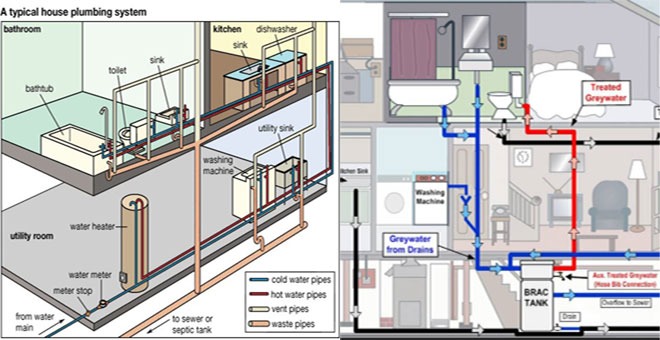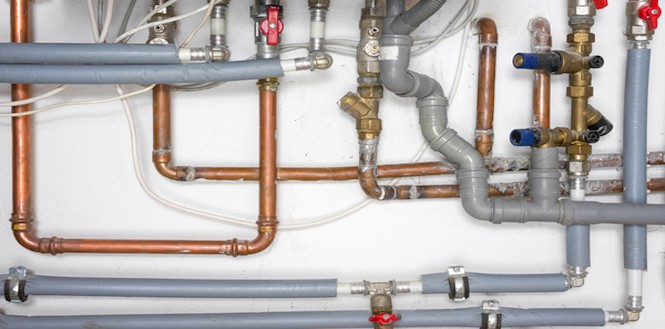This article down the page about Plumbing Installation 101: All You Need to Know is quite captivating. Don't overlook it.

Understanding just how your home's plumbing system works is essential for every single homeowner. From delivering tidy water for alcohol consumption, food preparation, and bathing to safely eliminating wastewater, a well-maintained pipes system is essential for your family's health and convenience. In this comprehensive overview, we'll check out the detailed network that makes up your home's plumbing and offer pointers on upkeep, upgrades, and taking care of typical concerns.
Intro
Your home's pipes system is more than simply a network of pipelines; it's a complicated system that guarantees you have accessibility to tidy water and effective wastewater elimination. Knowing its parts and just how they interact can aid you prevent pricey repairs and guarantee everything runs efficiently.
Standard Parts of a Plumbing System
Pipelines and Tubes
At the heart of your pipes system are the pipelines and tubes that carry water throughout your home. These can be constructed from numerous products such as copper, PVC, or PEX, each with its benefits in terms of toughness and cost-effectiveness.
Fixtures: Sinks, Toilets, Showers, and so on.
Fixtures like sinks, commodes, showers, and tubs are where water is made use of in your home. Understanding how these fixtures link to the pipes system helps in diagnosing troubles and planning upgrades.
Shutoffs and Shut-off Factors
Valves control the circulation of water in your pipes system. Shut-off shutoffs are crucial during emergencies or when you need to make repair services, permitting you to separate parts of the system without interfering with water circulation to the entire house.
Water Supply System
Main Water Line
The major water line attaches your home to the local water system or an exclusive well. It's where water enters your home and is dispersed to various fixtures.
Water Meter and Stress Regulatory Authority
The water meter measures your water use, while a pressure regulatory authority makes certain that water flows at a safe pressure throughout your home's pipes system, protecting against damages to pipelines and fixtures.
Cold Water vs. Warm water Lines
Recognizing the distinction between cold water lines, which supply water straight from the primary, and warm water lines, which carry heated water from the hot water heater, assists in fixing and preparing for upgrades.
Water drainage System
Drain Pipes Water Lines and Traps
Drain pipes carry wastewater away from sinks, showers, and commodes to the drain or sewage-disposal tank. Traps prevent sewer gases from entering your home and additionally catch particles that can cause blockages.
Ventilation Pipes
Air flow pipelines permit air right into the drain system, avoiding suction that might slow drainage and cause traps to empty. Appropriate ventilation is essential for preserving the integrity of your pipes system.
Importance of Proper Water Drainage
Making sure proper drainage prevents back-ups and water damages. Routinely cleansing drains and maintaining traps can avoid pricey repair work and prolong the life of your pipes system.
Water Furnace
Types of Hot Water Heater
Hot water heater can be tankless or typical tank-style. Tankless heating units warm water on demand, while tanks store heated water for prompt usage.
Upgrading Your Plumbing System
Factors for Updating
Upgrading to water-efficient fixtures or replacing old pipelines can boost water high quality, minimize water costs, and increase the worth of your home.
Modern Plumbing Technologies and Their Advantages
Check out innovations like wise leakage detectors, water-saving commodes, and energy-efficient water heaters that can conserve cash and reduce ecological impact.
Expense Considerations and ROI
Determine the upfront costs versus long-lasting cost savings when taking into consideration plumbing upgrades. Lots of upgrades spend for themselves through lowered utility costs and less repair services.
Exactly How Water Heaters Connect to the Pipes System
Comprehending just how water heaters attach to both the cold water supply and warm water distribution lines helps in identifying concerns like insufficient hot water or leakages.
Maintenance Tips for Water Heaters
Routinely flushing your water heater to eliminate debris, checking the temperature settings, and examining for leaks can prolong its life-span and enhance power performance.
Common Pipes Problems
Leakages and Their Reasons
Leakages can take place due to aging pipelines, loose fittings, or high water stress. Dealing with leakages promptly stops water damages and mold growth.
Clogs and Clogs
Obstructions in drains and commodes are often brought on by purging non-flushable things or a buildup of grease and hair. Using drain screens and being mindful of what decreases your drains can stop obstructions.
Signs of Plumbing Problems to Look For
Low tide pressure, slow-moving drains, foul odors, or unusually high water expenses are signs of prospective pipes problems that should be dealt with without delay.
Pipes Upkeep Tips
Routine Evaluations and Checks
Set up annual plumbing examinations to capture concerns early. Look for indicators of leaks, corrosion, or mineral build-up in faucets and showerheads.
DIY Maintenance Tasks
Simple jobs like cleaning faucet aerators, checking for bathroom leaks making use of dye tablets, or shielding exposed pipes in chilly climates can protect against significant pipes issues.
When to Call a Specialist Plumbing Technician
Know when a plumbing problem calls for expert proficiency. Trying complicated repair services without proper understanding can result in even more damage and higher repair work costs.
Tips for Lowering Water Usage
Basic routines like fixing leakages immediately, taking much shorter showers, and running full tons of washing and recipes can preserve water and reduced your energy costs.
Eco-Friendly Plumbing Options
Think about lasting pipes products like bamboo for floor covering, which is durable and environmentally friendly, or recycled glass for counter tops.
Emergency situation Readiness
Actions to Take During a Pipes Emergency
Know where your shut-off valves are located and how to shut off the water in case of a burst pipeline or major leakage.
Importance of Having Emergency Situation Get In Touches With Useful
Keep contact details for local plumbings or emergency situation solutions conveniently offered for quick feedback during a plumbing situation.
Ecological Effect and Preservation
Water-Saving Components and Appliances
Mounting low-flow taps, showerheads, and commodes can considerably reduce water usage without giving up efficiency.
DIY Emergency Fixes (When Appropriate).
Short-term solutions like utilizing duct tape to spot a dripping pipe or putting a container under a leaking faucet can decrease damages till a professional plumbing technician arrives.
Conclusion.
Comprehending the composition of your home's pipes system encourages you to keep it successfully, saving time and money on fixings. By adhering to routine upkeep routines and staying educated about modern-day plumbing innovations, you can guarantee your pipes system runs successfully for several years to come.
HOW YOUR PLUMBING SYSTEM WORKS
Which Pipes Do What?
Blue lines = fresh water supply entering the building Red lines = hot water supply entering the building Grey lines = pipes carrying waste away from the building and venting pipes carrying gases away from the building (through the roof) YOUR MAIN PLUMBING SYSTEMS
There are two main plumbing systems that support your home s basic plumbing needs one that brings clean water into your home, and one that sends dirty water away from your home. Connected to the toilet, bath, shower, and other faucets in your home, these two systems keep your water flowing in the right directions.
ACCESSING FRESH WATER
Fresh and clean water is brought into your home through the main water supply line . Filtered through one pipe, this water is pressured to flow into the various fixtures in your home at any given time.
This water can be sourced from a well located on your property, a pond or river (mostly cottages), or, as in most cases, from the city s municipal water treatment centre. However, it is important to note that water that is untreated, such as the water siphoned from ponds or rivers, may not be safe to drink. Personal water supplies always need to be treated for hardness and contaminants before consumed.
MUNICIPAL WATER SUPPLIES
Improve taste and odour Remove sediment Eliminate hardness Reduce chlorine COLD WATER SUPPLY VS. HOT WATER SUPPLY
Cold water flows into your home or building through the service line, which then distributes hot or cold water to your fixtures. This line is most commonly run through a central column that runs floor to floor. Hot water runs in short and straight pipes as the longer the pipeline, the more heat that will be lost in the transfer. Having shorter pipes also allows residents to access hot water more quickly.
WASTE WATER SYSTEM
Your wastewater system is divided into two parts pipes that send wastewater away from your home and venting pipes that send sewer gas away from your home. Sewage water travels through pipes that flush the water and waste towards local sewers that are operated and managed by your city or town. Most sewer systems rely on gravity to move the wastewater to where it needs to go.
The further away from your toilet or sink, the larger wastewater pipes become. This allows for waste to be disposed of from various parts of your home or business at once without pipe blockages. The angle and flow of these pipes are also essential for keeping your waste pipes clear of build up.
https://harrisplumbing.ca/how-your-home-plumbing-system-works/

As a person who reads about , I think sharing that piece of content was a great idea. Are you aware of someone else who is looking into the niche? Do not hesitate to promote it. I value your readership.
Schedule Today!